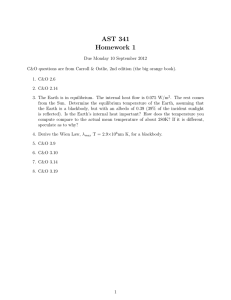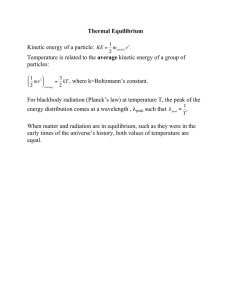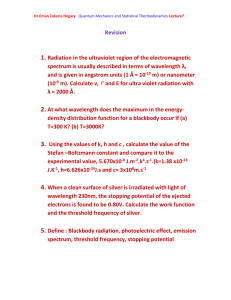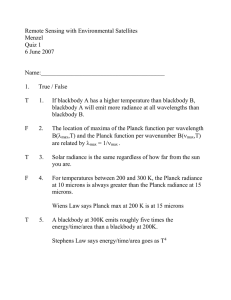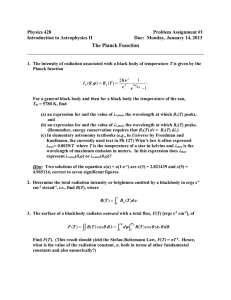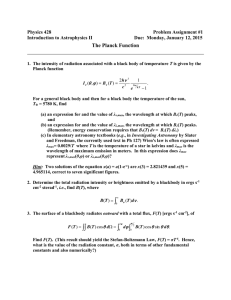Chapter 13 Blackbody Radiation and Lasers
advertisement
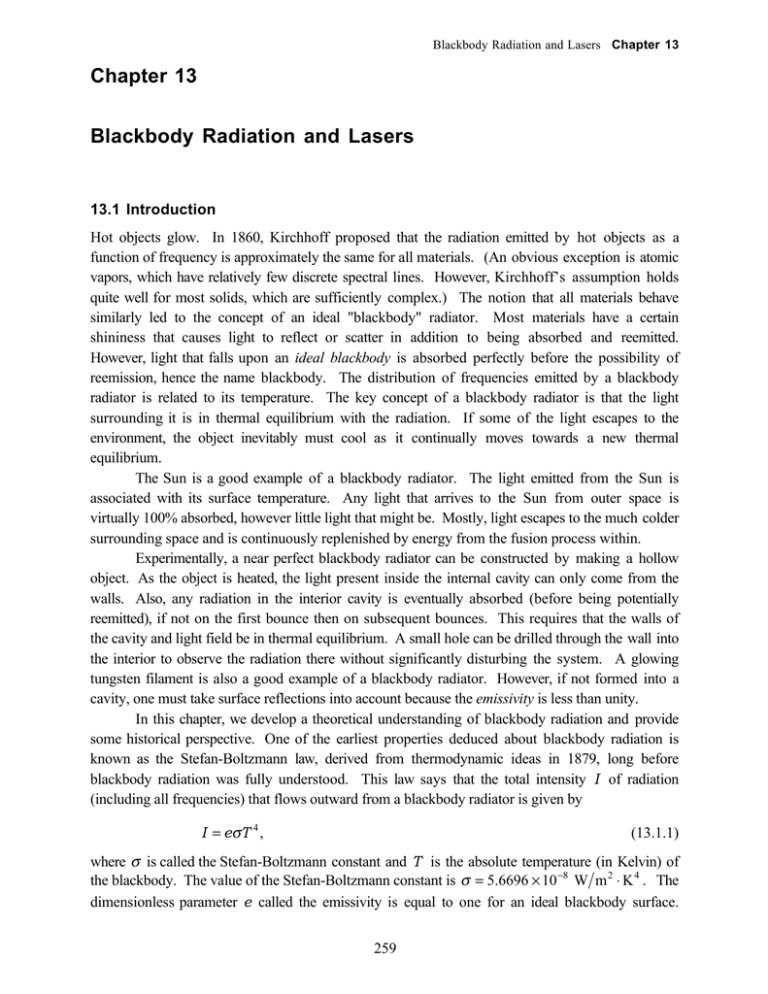
Blackbody Radiation and Lasers Chapter 13 Chapter 13 Blackbody Radiation and Lasers 13.1 Introduction Hot objects glow. In 1860, Kirchhoff proposed that the radiation emitted by hot objects as a function of frequency is approximately the same for all materials. (An obvious exception is atomic vapors, which have relatively few discrete spectral lines. However, Kirchhoff’s assumption holds quite well for most solids, which are sufficiently complex.) The notion that all materials behave similarly led to the concept of an ideal "blackbody" radiator. Most materials have a certain shininess that causes light to reflect or scatter in addition to being absorbed and reemitted. However, light that falls upon an ideal blackbody is absorbed perfectly before the possibility of reemission, hence the name blackbody. The distribution of frequencies emitted by a blackbody radiator is related to its temperature. The key concept of a blackbody radiator is that the light surrounding it is in thermal equilibrium with the radiation. If some of the light escapes to the environment, the object inevitably must cool as it continually moves towards a new thermal equilibrium. The Sun is a good example of a blackbody radiator. The light emitted from the Sun is associated with its surface temperature. Any light that arrives to the Sun from outer space is virtually 100% absorbed, however little light that might be. Mostly, light escapes to the much colder surrounding space and is continuously replenished by energy from the fusion process within. Experimentally, a near perfect blackbody radiator can be constructed by making a hollow object. As the object is heated, the light present inside the internal cavity can only come from the walls. Also, any radiation in the interior cavity is eventually absorbed (before being potentially reemitted), if not on the first bounce then on subsequent bounces. This requires that the walls of the cavity and light field be in thermal equilibrium. A small hole can be drilled through the wall into the interior to observe the radiation there without significantly disturbing the system. A glowing tungsten filament is also a good example of a blackbody radiator. However, if not formed into a cavity, one must take surface reflections into account because the emissivity is less than unity. In this chapter, we develop a theoretical understanding of blackbody radiation and provide some historical perspective. One of the earliest properties deduced about blackbody radiation is known as the Stefan-Boltzmann law, derived from thermodynamic ideas in 1879, long before blackbody radiation was fully understood. This law says that the total intensity I of radiation (including all frequencies) that flows outward from a blackbody radiator is given by I = esT 4 , (13.1.1) where s is called the Stefan-Boltzmann constant and T is the absolute temperature (in Kelvin) of the blackbody. The value of the Stefan-Boltzmann constant is s = 5.6696 ¥ 10 -8 W m 2 ◊ K 4 . The dimensionless parameter e called the emissivity is equal to one for an ideal blackbody surface. 259 Physics of Light and Optics © 2001 Peatross Chapter 13 However, it is less than one for actual materials because of surface reflections. For example, the emissivity of tungsten is approximately e = 0.4 . It is sometimes useful to express intensity in terms of the energy density of the light field ufield (given by (2.5.5) in units of energy per volume). This connection between outward-going intensity and energy density of the field is given by I = cufield 4sT 4 fi ufield = e , c 4 (13.1.2) since the energy travels at speed c equally in all directions (for example, inside a cavity within a solid object). A factor of 1 2 occurs because only half of the energy travels away from rather than towards any given surface (e.g. the wall of the cavity). The remaining factor of 1 2 occurs because the energy that flows outward through a given surface is directionally distributed over a hemisphere as opposed to flowing only in the direction of the surface normal n̂ . This average over the hemisphere is carried out as follows: p 2 2p Ú df Ú 0 2p 0 p 2 0 0 Ú df Ú r sin qdq p 2 2p v r ◊ nˆ sin qdq = Ú df Ú r cosq sin qdq 0 2p 0 p 2 Ú df Ú r sin qdq 0 = 1 . 2 (13.1.3) 0 The thermodynamic derivation of the Stefan-Boltzmann law is given in appendix 13.A. Although (13.1.1) describes the total intensity of the light that leaves a blackbody surface, it does not describe what frequencies make up the radiation field. This frequency distribution was not fully described for another two decades when Max Planck developed his famous formula. Planck first arrived at the blackbody radiation formula empirically in an effort to match experimental data. He then attempted to explain it, which marks the birth of quantum mechanics. Even Planck was uncomfortable with and perhaps disbelieved the assumptions that his formula implied, but he deserves credit for recognizing and articulating those assumptions. In section 13.3, we study how Planck's blackbody radiation formula implies the existence of electromagnetic quanta, which we now call photons. However, in section 13.2 we first examine the failure of classical ideas to explain blackbody radiation (even though this failure was only appreciated years after Planck developed his formula). Section 13.4 gives an analysis of blackbody radiation developed by Einstein where he introduced the concept of stimulated and spontaneous emission. In this sense, Einstein can be thought of as the father of light amplification by stimulated emission of radiation (LASER). Exercises P13.1.1 The Sun has a radius of RS = 6.96 ¥ 108 m . What is the total power that it radiates, given a surface temperature of 5750 K? P13.1.2 A 1cm -radius spherical ball of polished gold hangs suspended inside an evacuated chamber that is at room temperature ( 20o C). There is no pathway for thermal conduction to the chamber wall. 260 Blackbody Radiation and Lasers Chapter 13 (a) If the gold is at a temperature of 100o C, what is the initial rate of temperature loss in o C s ? The emissivity for polished gold is e = 0.02 . The specific heat of gold is 129 J kg ◊ o C and its density is 19.3 g cm 3 . HINT: Q = mcDT and Power = Q Dt . (b) What is the initial rate of temperature loss if the ball is coated with flat black paint, which has emissivity e = 0.95 ? HINT: You should consider the intensity flowing both ways. 13.2 Failure of the Equipartition Principle In the latter part of the 1800's as spectrographic technology improved, experimenters acquired considerable data on the spectra of blackbody radiation. Experimentalists were able to make detailed maps of the intensity per frequency associated with blackbody radiation over a fairly wide wavelength range. The results appeared to be independent of the material from which the object under study was constructed, and this suggested general underlying physical reasons for the behavior. The intensity per frequency depended only on temperature and when integrated over all frequencies agreed with the Stefan-Boltzmann law (13.1.1). In 1900, Rayleigh (and later Jeans in 1905) attempted to explain the blackbody spectral distribution (intensity per frequency) as a function of temperature by applying the equipartition theorem to the problem. Recall, the equipartition theorem states the energy in a system on the average is distributed equally among all degrees of freedom in the system. For example, a system composed of oscillators (say, electrons attached to 'springs' representing the response of the material on the walls of a blackbody radiator) has an energy of kBT 2 for each degree of freedom, where kB = 1.38 ¥ 10 -23 J K is Boltzmann's constant. Rayleigh and Jeans supposed that each unique mode of the electromagnetic field should carry energy kBT just as each mechanical spring in thermal equilibrium carries energy kBT ( kBT 2 as kinetic and kBT 2 as potential energy). The problem then reduces to that of finding the number of unique modes for the radiation at each frequency. They anticipated that requiring each mode of electromagnetic energy to hold energy kBT should reveal the spectral shape of blackbody radiation. A given frequency is associated with a specific wave number k = kx2 + ky2 + kz2 . Notice that there are many ways (i.e. combinations of kx , ky , and kz ) to come up with the same wave number k = 2pn c (corresponding to a single frequency n ). To count these ways properly, we can let our experience with Fourier series guide us. Consider a box with each side of length L . The Fourier theorem (0.4.3) states that the total field inside the box (no matter how complicated the distribution) can always be represented as a superposition of sine (and cosine) waves. The total field in the box can therefore be written as • • Ï • i nk x + mko y + lko z ) ¸ Re Ì Â Â Â En ,m , le ( o ˝, Ón = -• m = -• l = -• ˛ (13.2.1) where each component of the wave number in any of the three dimensions is always an integer times ko = 2p L . (13.2.2) 261 Physics of Light and Optics © 2001 Peatross Chapter 13 We must keep in mind that (13.2.1) does not account for the two distinct polarizations for each wave. To find the total number of modes associated with a given frequency, we should double the number of terms in (13.2.1) that have that frequency. It is important to note that we have not artificially made any restrictions by considering the box of size L since we may later take the limit L Æ • so that our box represents the entire universe. In fact, L naturally disappears from our calculation as we consider the density of modes. dk ko k ko (4pk 2 ) ko3 dk Fig. 13.1 The volume of a thin spherical shell in n , m , l space. We can think of a given wave number k as specifying the equation of a sphere in a fictitious n , m , and l space: 2 Êkˆ n +m + l = Á ˜ . Ë ko ¯ 2 2 2 (13.2.3) We need to know how many more ways there are to choose n , m , and l when the wave number k ko is replaced by (k + dk ) ko . The answer is the difference in the volume of the two spheres as shown in Fig. 13.1: Ê k 2 ˆ dk # modes in (k , k + dk ) = Á 4p 2 ˜ . Ë ko ¯ ko (13.2.4) This represents the number of ways to come up with a wave number between k and k + dk . Again, this is the number of terms in (13.2.1) with a wave number between k and k + dk . Recall that n , m , and l are integers so our fictitious space has natural units of 1. Notice that we have included the possibility of negative integers. This automatically takes into account the fact that for each mode (defined by a set n , m , and l) the field may travel in the forwards or the backwards direction. Since according to the Rayleigh-Jeans assumption each mode carries energy of kBT , the energy density (energy per volume) associated with a specified range of wave numbers dk is kBT L3 times (13.2.4), the number of modes within that range. Thus, the total energy density in the field for all wave numbers is 262 Blackbody Radiation and Lasers Chapter 13 • ufield = Ú 2 ¥ 0 • kBT 4pk 2 k2 ¥ dk = k T B Ú 2 dk , L3 ko3 p 0 (13.2.5) where the extra factor of 2 accounts for two independent polarizations for each mode. The dependence on L has disappeared from (13.2.5). It is immediately apparent that (13.2.5) disagrees drastically with the Stefan-Boltzmann law (13.1.2) (i.e. proportional to temperature rather than its fourth power). In addition, the integral in (13.2.5) is seen to diverge, meaning that regardless of the temperature, the light carries infinite energy density! This has since been named the ultraviolet catastrophe since the divergence occurs on the short wavelength end of the spectrum. This is a clear failure of classical physics to explain blackbody radiation. Nevertheless, Rayleigh emphasized the fact that his formula worked well for the longer wavelengths and he did not necessarily want to abandon classical physics. Such dramatic changes take time. It is instructive to make the change of variables k = 2pn c in the integral to write • 8pn 2 3 dn . c 0 ufield = kBT Ú (13.2.6) The important factor 8pn 2 c 3 can now be understood to be the number of modes per frequency. Then (13.2.6) is rewritten as • ufield = Ú r(n )dn , where (13.2.7) 8pn 2 c3 (13.2.8) 0 rRayleigh (n ) = kBT Jeans describes (incorrectly) the spectral energy density of the radiation field associated with blackbody radiation. 13.3 Planck's Formula In the late 1800’s Wien considered various physical and mathematical constraints on the spectrum of blackbody radiation and tried to find a function to fit the experimental data. The form for the energy distribution of blackbody radiation that Wien proposed was rWien (n ) = 8phn 3e -hn k BT . c3 (13.3.1) It is important to note that the constant h had not yet been introduced by Planck. The actual way that Wien wrote his distribution was rWien (n ) = an 3e -bn T , where a and b were parameters used to fit the data. Wien's formula did a good job of fitting experimental data. However, in 1900 Lummer and Pringshein reported experimental data that deviated from the Wien distribution at long wavelengths 263 Physics of Light and Optics © 2001 Peatross Chapter 13 (infrared). Max Planck was privy to this information and later that year came up with a revised version of Wien's formula that fit the data beautifully everywhere: rPlanck (n ) = [ 8phn 3 ] c 3 e hn k BT - 1 , (13.3.2) where h = 6.626 ¥ 10 -34 J ◊ s is an experimentally determined constant. 1.5 r(n ) units of 8pkB3 T 3 h 2c 3 Planck Wien Rayleigh-Jeans 1 0.5 0 0 2 4 6 k T n units of B h 8 10 Fig. 13.2 Energy density per frequency according to Planck, Wien, and Rayleigh-Jeans. As seen in Fig. 13.2, the Rayleigh-Jeans curve, (13.2.8), and the Wien curve, (13.3.1), both fit the Planck's distribution function asymptotically on opposite ends. As is evident, the Wien distribution does a good job nearly everywhere. However, at long wavelengths it was off by just enough for the experimentalists to notice that something was wrong. At this point, it may seem fair to ask, what did Planck do that was so great? After all, he simply guessed a function that was only a slight modification of Wien's distribution. And he knew the 'answer from the back of the book,' namely Lummer's and Pringshein's well done experimental results. (At the time, Planck was unaware of the work by Rayleigh.) What Planck did that was so great was to interpret the meaning of his new formula. His interpretation was what he called an "act of desperation." While Planck was able to explain the implications of his formula, he did not assert that the implications were necessarily right; in fact, he presented them somewhat apologetically. It was several years later that the young Einstein published his paper explaining the photoelectric effect in terms of the implications of Planck's formula. Planck's insight was an enormous step towards understanding the quantum nature of light. The full theory of quantum electrodynamics would not be developed until nearly three decades later. Students should appreciate that the very people who developed quantum mechanics were also bothered by its confrontation with deep-seated intuition. If quantum mechanics bothers you, you should feel yourself in good company! Planck found that he could derive his formula only if he made the following strange assumption: A given mode of the electromagnetic field is not able to carry an arbitrary amount of energy (for example, kBT which varies continuously as the temperature varies). Rather, the field can only carry discrete amounts of energy separated by spacing hn . Under this assumption, the 264 Blackbody Radiation and Lasers Chapter 13 probability Pn that a mode of the field is excited to the n th level is proportional to the Boltzmann statistical weighting factor e -nhn k BT . We can normalize this factor by dividing by the sum of all such factors to obtain the probability of having energy nhn in a particular mode: Pn = e -nhn k BT • Âe - mhn k BT [ ] = e -nhn k BT 1 - e -hn k BT . (13.3.3) m =0 Then, the energy in each mode of the field is expected to be • [ Â hnnPn = hn 1 - e -hn k BT n ] • [ ] Â ne -nhn k BT = hn e -hn k BT - 1 n • ∂ hn e -nhn k BT = hn k T Â B ∂ (hn kBT ) n e -1 (13.3.4) Equation (13.3.4) is interpreted as the expectation of the energy (associated with an individual frequency) based on probabilities consistent with thermal equilibrium. Finally, we multiply this expected energy by the mode density 8pn 2 c 3 , obtained in the derivation of the Rayleigh-Jeans formula. In other words, we substitute (13.3.4) for kBT in (13.2.7) to obtain the Planck distribution (13.3.2). It is interesting that we are now able to derive the constant in the Stefan-Boltzmann law (13.1.2) in terms of Planck's constant h (see P13.3.1). The Stefan-Boltzmann law is obtained by integrating the spectral density function over all frequencies to obtain the total field energy density, which is in thermal equilibrium with the blackbody radiator: • ufield = Ú rPlank (n )dn = 0 4 2p 5kB4 4 4 4 2 3 T = sT . c 15c h c (13.3.5) The Stefan-Boltzmann constant is thus calculated in terms of Planck’s constant. However, Planck's constant was not introduced for several decades after the Stefan-Boltzmann law was developed. Thus, one may say that the Stefan-Boltzmann constant pins down Planck's constant. Exercises P13.3.1 Derive the Stefan-Boltzmann law by integrating the • (a) Rayleigh-Jeans energy density (i.e., ufield = Ú rRayleigh (n )dn ). Please comment. • 0 Jeans (b) Wien energy density (i.e. ufield = Ú rWien (n )dn ). Please evaluate s . • HINT: 0 Úx e 0 3 - ax dx = 6 . a4 265 Physics of Light and Optics © 2001 Peatross Chapter 13 • (c) Planck energy density (i.e. ufield = Ú rPlanck (n )dn ). Please evaluate s . Compare results of • (b) and (c). HINT: 0 p x dx 3 4 Ú e ax - 1 = 15a 4 . 0 0.00290 m ◊ K , which gives the strongest T wavelength present in the blackbody spectral distribution. P13.3.2 (a) Derive Wien's displacement law lmax = HINT: • • 0 0 Express ufield = Ú rPlanck (n )dn as ufield = Ú rPlanck (l )dl . Then find what l corresponds to the maximum of rPlanck (l ) . You may like to know that the solution to the transcendental equation (5 - x )e x = 5 is x = 4.965 . (b) What is the strongest wavelength emitted by the Sun, which has a surface temperature of 5750 K (see P13.1.1)? (c) Is lmax the same as c n max , where n max corresponds to the peak of rPlanck (n ) ? Why would we be interested mainly in lmax ? 13.4 Einstein's A and B Coefficients More than a decade after Planck introduced his formula, and after Bohr had proposed that electrons occupy discrete energy states in atoms, Einstein reexamined blackbody radiation in terms of Bohr’s new idea. If the material of a blackbody radiator interacts with a mode of the field with frequency n , then electrons in the material must make transitions between two energy levels with energy separation hn . Since the radiation of a blackbody is in thermal equilibrium with the material, Einstein postulated that the field stimulates electron transitions between the states. In addition, he postulated that some transitions must occur spontaneously. (If the possibility of spontaneous transitions is not included, then there can be no way for a field mode to receive energy if none is present to begin with.) Einstein wrote down rate equations for populations of the two levels N 1 and N 2 associated with the transition hn : N˙ 1 = A21 N 2 - B12 r(n ) N 1 + B21r(n ) N 2 , N˙ 2 = -A21 N 2 + B12 r(n ) N 1 - B21r(n ) N 2 . (13.4.1) The coefficient A21 is the rate of spontaneous emission from state 2 to state 1, B12 r(n ) is the rate of stimulated absorption from state 1 to state 2, and B21r(n ) is the rate of stimulated emission from state 2 to state 1. In thermal equilibrium, the rate equations (13.4.1) are both equal to zero (i.e., N˙ 1 = N˙ 2 = 0 ) since the relative populations of each level must remain constant. We can then solve for the spectral density r(n ) at the given frequency. Either expression in (13.4.1) yields r(n ) = A21 . N1 B12 - B21 N2 (13.4.2) 266 Blackbody Radiation and Lasers Chapter 13 In thermal equilibrium, the spectral density must match the Planck spectral density formula (13.3.2). In making the comparison, we should first rewrite the ratio N 1 N 2 of the populations in the two levels using the Boltzmann probability factor: N 1 e -E1 = N 2 e -E 2 k BT k BT = e( E 2 - E 1 ) k BT = e hn k BT . (13.4.3) Then when equating (13.4.3) to the Planck blackbody spectral density (13.3.2) we get A21 8phn 3 = . e hn k BT B12 - B21 c 3 e hn k BT - 1 [ ] (13.4.4) It is immediately apparent that B12 = B21 , and A21 = (13.4.5) 8phn 3 B21 . c3 (13.4.6) We see from (13.4.5) that the rate of stimulated absorption is the same as the rate of stimulated emission. In addition, if one knows the rate of stimulated emission between a pair of states, it follows from (13.4.6) that one also knows the rate of spontaneous emission. This is remarkable because to derive A21 directly, one needs to use the full theory of quantum electrodynamics (the complete photon description). However, to obtain B21 , it is actually only necessary to use the semiclassical theory, where the light is treated classically and the energy levels in the material are treated quantum-mechanically using the Schrödinger equation. The usual semiclassical theory cannot explain spontaneous emission, but it can explain stimulated emission and the rate of sponaneous emission can then be obtained indirectly through (13.4.6). It should be mentioned that (13.4.5) and (13.4.6) assume that the energy levels 1 and 2 are non-degenerate. Some modifications must be made in the case of degenerate levels, but the procedure is similar. In writing the rate equations, (13.4.1), Einstein predicted the possibility of creating lasers fifty years in advance of their development. These rate equations are still valid even if the light is not in thermal equilibrium with the material. The equations suggest that if the population in the upper state 2 can be made artificially large, then amplification will result via the stimulated transition. The rate equations also show that a population inversion (more population in the upper state than in the lower one) cannot be achieved by ‘pumping’ the material with the same frequency of light that one hopes to amplify. This is because the stimulated absorption rate is balanced by the stimulated emission rate. The material-dependent parameters A21 and B12 = B21 are called the Einstein A and B coefficients. Appendix 13.A Thermodynamic Derivation of the Stefan-Boltzmann Law In this appendix, we derive the Stefan-Boltzmann law. This derivation is included for historical interest and may be a little difficult to follow. The derivation relies on the 1st and 2nd laws of thermodynamics. Consider a container whose walls are all at the same temperature and in thermal 267 Physics of Light and Optics © 2001 Peatross Chapter 13 equilibrium with the radiation field inside, according to the properties of an ideal blackbody radiator. L u A V Fig. 13.3 Field inside a blackbody radiator. Notice that the units of energy density ufield (energy per volume) are equivalent to force per area, or in other words pressure. The radiation exerts a pressure of P = ufield 3 (13.A.1) on each wall of the box. This can be derived from the fact that radiation of energy DE imparts a momentum Dp = 2 DE cosq c (13.A.2) when it is absorbed and reemitted from a wall at an angle q . The fact that light carries momentum was understood well before the development of the theory of relativity and the photon description of light. The total pressure (force per area averaged over all angles) on a wall averages to be p 2 P= Ú 0 Dp 1 sin qdq Dt A p 2 , (13.A.3) Ú sin qdq 0 where A is the area of the wall and DE = ufield AL is the total energy in the box, which makes a round trip during the interval Dt = 2L (c cosq ) . L is the length of the box in the direction perpendicular to the surface. Upon performing the integration in (13.A.3), the simple result (13.A.1) is obtained. To derive the Stefan-Boltzmann law, consider entropy which is defined in differential form by the quantity dS = dQ , T (13.A.4) where dQ is the injection of heat (or energy) into the radiation field in the box and T is the temperature at which that injection takes place. We would like to write dQ in terms of ufield , V , and T . Then we may invoke the fact that S is a state variable, which implies 268 Blackbody Radiation and Lasers Chapter 13 ∂ 2S ∂ 2S = . ∂T∂V ∂V∂T (13.A.5) This is a mathematical statement of the fact that S is fully defined if the internal energy, temperature, and volume of system are specified. In other words, S does not depend on past temperature and volume history of a system, but is completely parameterized by the present state of the system. To obtain dQ in the form that we need, we can use the 1st law of thermodynamics, which is a statement of energy conservation: dQ = dU + PdV = d (ufieldV ) + PdV (13.A.6) 1 dufield 4 = Vdufield + ufielddV + ufielddV = V dT + ufielddV . 3 dT 3 Notice that we have used energy density times volume to obtain the total energy U in the radiation field in the box. We have also used (13.A.1) to obtain the work accomplished by pressure as the volume changes. A change in internal energy dU = d (ufieldV ) can take place by the injection of heat dQ or by doing work dW = PdV as the volume increases. We can use (13.A.6) to rewrite (13.A.4): dS = V dufield 4u dT + field dV . T dT 3T (13.A.7) When we differentiate (13.A.7) with respect to temperature or volume we get ∂S V dufield = , ∂T T dT ∂S 4ufield = . ∂V 3T (13.A.8) We are now able to evaluate the partial derivatives in (13.A.5), which give ∂ 2S 4 ∂ ufield 4 1 ∂ufield 4 ufield ∂ 2S 1 dufield = = , = 2 ∂T∂V 3 ∂T T 3 T ∂T 3 T ∂V∂T T dT . (13.A.9) Finally, (13.A.5) becomes a differential equation relating the internal energy of the system to the temperature: 4 1 ∂ufield 4 ufield 1 dufield ∂ufield 4ufield fi = . 2 = 3 T ∂T 3 T T dT ∂T T (13.A.10) The solution to this differential equation is (13.1.2), where 4s c is a constant to be determined experimentally (or derived from the Planck blackbody formula as was done in (13.3.5)). 269
